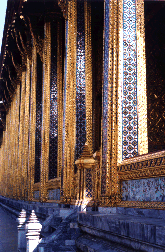 Inside the ubosoth containing the EmeraId Buddha there also are other interesting items:
Inside the ubosoth containing the EmeraId Buddha there also are other interesting items:
Computerized by LCDR. WUTTIPONG PONGSUWAN and NIKORN LIMCHAROEN
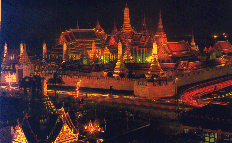 The construction of the Temple of the Emerald Buddha in the First Reign can be divided into two periods. During the first the boundaries of the Temple on the north and the cast were even more limiting than at the present time. The temple compound was e
nclosed by galleries (no. 22 on the plan, at the back), and in the south was built the ubosoth (the ordination hall, no. I) enshrining the Emerald Buddha as its main image. Other construction, as we shall see, was to follow.
The construction of the Temple of the Emerald Buddha in the First Reign can be divided into two periods. During the first the boundaries of the Temple on the north and the cast were even more limiting than at the present time. The temple compound was e
nclosed by galleries (no. 22 on the plan, at the back), and in the south was built the ubosoth (the ordination hall, no. I) enshrining the Emerald Buddha as its main image. Other construction, as we shall see, was to follow.
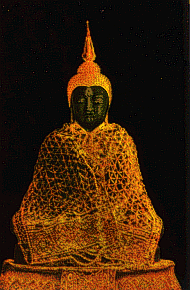 The History of the Emerald Buddha. The Emerald Buddha is in reality carved From a large piece of green jade. According to a reliable chronicle, in 1434 A.D. lightning struck a chedi in Chiengrai in northern Thailand and a Buddha statue covered with s
tucco was found inside. The image was brought into the abbot's residence and one day he noticed that the stucco on the nose had flaked off and the image inside was green in color. He removed all the stucco and found the Emerald Buddha. (The word emerald
here only means "green colored" in Thai.)
The History of the Emerald Buddha. The Emerald Buddha is in reality carved From a large piece of green jade. According to a reliable chronicle, in 1434 A.D. lightning struck a chedi in Chiengrai in northern Thailand and a Buddha statue covered with s
tucco was found inside. The image was brought into the abbot's residence and one day he noticed that the stucco on the nose had flaked off and the image inside was green in color. He removed all the stucco and found the Emerald Buddha. (The word emerald
here only means "green colored" in Thai.)
People then flocked to worship this precious statue. At that time the town of Chiengrai was under the rule of the king of Chiengmai. The latter, King Samfangkaen, sent an elephant to bring the Emerald Buddha to Chiengmai, but each time the elephant arrived at the junction with the road to the city of Lampang, it ran to that town. The king sent an elephant out three times and each time the same incident occurred, so he thought that the spirits guarding the Emerald Buddha wanted to stay in lampang. T hus the Emerald Buddha was allowed to remain in Lampang for 32 years, until 1468, when Chiengmai had a powerful king, King Tiloka. He had the Emerald Buddha brought to Chiengmai and, according to one chronicle, installed the image in the eastern niche of a large stupa called Chedi Luang.
In 1551 the King of Chiengmai, who had no son, died. One of his daughters was married to the king of Laos. She had borne one son, named Prince Chaichettha. When the king of Chiengmai died the ministers of Chiengmai invited the prince, who was fifte en, to become king and he accepted. However, when his father, the king of Laos, passed away, King Chaichettha wanted to go back to his own country, so in 1552 he returned to Luang Prabang, the then capital of Laos, taking the Emerald Buddha with him, and promised the ministers of Chiengmai to come back. He never returned nor did he send back the Emerald Buddha, so the image remained at Luang Prabang for twelve years.
In 1564 King Chaichettha could not resist the Burmese army of King Burannaung; thus he moved his capital down to Vientiane and the Emerald Buddha remained there for 214 years.
In 1778, during the Thonburi period, when King Rama I of Bangkok was still a general, he captured Vientiane and brought the Emerald Buddha back to Thailand. With the establishment 0 Bangkok as the capital, the Emerald Buddha became the palladium of Thailand and has been ever since. The image was moved from Thonburi to the Temple of the Emerald Buddha in Bangkok on 22 March 1784.
King Rama I had two seasonal costumes made for the Emerald Buddha, one for summer and one for the rainy season King Rama Ill (I824-1851) added another one for winter. The ceremony of changing the costumes of the Emerald Buddha. takes place three ti mes a year. In the old days the king wool' spray lustral water only on the princes and officials who were attending the ceremony inside the ubosoth. But during the present reign, His Majesty the King also sprays lustral water upon hi subjects who are wait ing outside the ordination hall. It can b regarded as a new tradition inaugurated in this reign.
The lap of the Emerald Buddha is 48.3 cm. wide and the height, including the base, is 66 cm. The image is in a seated. position, with the right leg resting on the left one. Judging from this iconographic factor, one could conclude that it was carve in Northern Thailand not much earlier than the fifteenth century A.D. and belongs to the late Northern Thai, that is to say, the late Chiengsaen or Chiengmai school. If this is so, it must has been made not long before its discovery in the stupa in Chien grai.
On the other hand, the Emerald Buddha, which is in the altitude of meditation, looks much like some of the Buddha images of Southern India and Sri Lanka, especially those in this same attitude. The attitude of meditation has never been popular in Th ai images of the Buddha. Thus one might assign the origin of the Emerald Buddha to one of the aforementioned countries.
 Inside the ubosoth containing the EmeraId Buddha there also are other interesting items:
Inside the ubosoth containing the EmeraId Buddha there also are other interesting items:
The gold-covered wooden throne, made in the First Reign, on which the Emerald Buddha sits. H.R.H. Prince Naris, one of the most famous architects and artists of the Bangkok periods, admired it greatly. He wrote that it was the best of its kind he had ever seen in Bangkok. Originally the golden throne rested on what now is its lowest base, but King Rama 111 added the intermediary one.
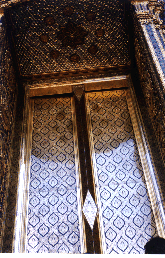 2. The mother of-pearl door-panels made its the First
Reign of Bangkok following the style of the late Ayudhya period.
2. The mother of-pearl door-panels made its the First
Reign of Bangkok following the style of the late Ayudhya period.
3. Two large standing crowned Buddha images dedicated
to King Rama I and King Rama II. In the reign of
King Rama Ill, the public called the reign of King Rama I ``The
Beginning Reign" and that of King Rama 11 ``The Middle Reign.'
King Rama 111 thought that giving each reign such an appellation
was a bad omen for the dynasty since it suggested that his would
be the last reign. Thus in 1841 he had `so large standing crowned
Buddha images cast in bronze. About 3 In. high, they are in the
attitude of calming the ocean and are covered with gold and
precious gems. He named the one placed on the northern side
of the Emerald Buddha ``Phra Puttha Yodfa Chulalok," and
the one on the south, "Phra Puttha Lerdla Napalai," and dedicated
theta, respectively, to King Rama I and King Rama 11 A proclamation-
was then issued for the public to call the first two kings by
these official names. These two Buddha images were worshipped at the ceremony
in which officials took the oath of allegiance to the king beginning
with the reign of King Rama IV (King Mongkut, 1851-1 868). The
ceremony was discontinued, however, after the revolution in
1932 leading to the establishment of the constitutional monarchy.
4. A small bronze Buddha image salted Phra Samputtha Panni created by King Rama IV in 1830 when he was still in the monkshood. The monk-prince invented a new type of Buddha image without a cranial protuberance, wearing a pleated monastic robe and seated in the attitude of meditation. Phra Samputtha Panni has been placed in front of the throne supporting the Emerald Buddha.
5. Ten crowned Buddha images in bronze in the attitude of calming the ocean. They are covered with gold and were installed in pairs on the base supporting the throne of the Emerald Buddha. They were created by successive kings of the present Chakri Dynasty and were dedicated to high members of the royal family, both male and female, from the First to the Third Reigns.
6. Mural paintings inside the ubosoth. The scene of the Buddhist cosmology (the Three `Worlds of Desire, Form and Non-Form) on the western wall behind the Emerald Buddha and that of the Enlightenment of the Buddha on the eastern, or front wall, were painted in the reign of' King Rama 1. At that time there probably was portrayed on the tipper part of the lateral walls the assembly of celestial beings who came to worship the main Buddha image in the ubosoth, a feature typical of the late Ayudhya and early Bangkok painting styles. The walls between the window's were decorated with scenes from the Life of the Buddha. King Rama ll. had the lateral walls repainted. Above the window's on both the north and the south were depicted scenes from the Life of the Buddha whereas between the windows various scenes from the jataka (previous lives of the Buddha) were shown. On the depicted and the southern side shows a riverine procession. These paintings still exist.
In the scene of the Enlightenment of the Buddha or always sees the Buddha seated under the Bodhi tree either in the attitude of meditation (having the right hand on the left one the lap) or subduing Mara (having the right hand on the right knee with the palm facing inward and the fingers pointing to the ground with the left hand on the lap). The Earth Goddess is underneath wringing out water from her hair, and the Buddha is flanked both sides by the army of Mara (evil spirits); on one side they at trying to attack the Master and on the other they have already bee subjugated. According to the Life of the Buddha, before Enlightenment Mara came and asked the Buddha what right he had to attain Enlightenment in this life and bring people out of ignorance The Buddha replied that in Isis past lives (a Buddhist believes rebirth) lie had accumulated enough merit to attain Enlightenment in this life. (Usually when one performs deeds of merit, even nowadays, one has to pour water on the ground to make the Earth Goddess one's witness and also to give merit to the dead.) The Buddha then changed his attitude from meditation to that of subduing Mara by placing his right hand on his right knee calling the Earth Goddess up from the ground. She wrung from her hair the water accumulated from the deeds of merit that the Buddha had performed in his previous lives and this drowned the whole of Mara's army. The Buddha then continued his meditation unt il lie arrived at the Supreme Enlightenment.
Sometimes this scene is explained as an allegory of personification of the thought of the Buddha. During this period the Buddha "as undergoing a mental struggle as to whether he should go back to worldly pleasure or continue his meditation until he arrived at the Supreme Enlightenment. Once he had decided to continue his meditation, he put his right hand on his right knee as a sign of his determination not to get up from his seat until his great desire had been accomplished.
7. Bronze lion door-guardians. There are altogether twelve, in six pairs. It had been believed that the pair guarding the main central door of the ubosoth on the east, which can be entered only by the Chief of State, was brought from Cambodia by command of King Rama I and the rest were copied in that reign. However, Professor Boisselier, the renowned French expert on Khmer Art, examined the central pair of lion-guardians and concluded that the design on their chest is Thai in style rather than Khmer. They probably were cast by Thai artisans copying Khmer lions. On both sides of the main staircase in front of the Royal Pantheon (no. 9) on the east sit two stone lion-guardians. Though they have been very much restored, one can perceive that they belong to the Khmer Bayon style (about the early thirteenth century A.D.). Therefore it might be that this pair of stone lions was brought from Cambodia during the reign of King Rama I and the bronze ones were cast in that reign to copy them.
In addition to the ubosoth containing the Emerald Buddha, King Rama I also had twelve small open pavilions built around it. North of the ubosoth at the site of the present Library or Phra Mondop, lie had a library in the late Ayudhya and early Bangkok fashions constructed in the middle at a pond in order to keep the termites from coming to eat the holy palm-leaf manuscripts. The building was also used in that reign by those translating foreign correspondence. On the east of the pond, at the present site of the Royal Pantheon, two gilded stupa were built on the ground in commemoration of the king's parents. A belfry was also constructed south of the ubosoth for bronze bell, valued for its rich sound, that been removed from Wat Saket in Bangkok.
In 1788 King Rama I had the Tripitaka (the Buddhist Holy Manuscripts) revised at Wat Mahathat, and after the revision was completed, transferred a new' copy of it to the new library inside the Temple of the Emerald Buddha and ordered a grand celebration. Unfortunately sparks from fireworks fell on the roof of the library and burnt it down but the Tripitaka was saved in time. During the second phase of construction under King Rama I, the king had the pond under the library filled up, enlarged the boundaries of the Temple on both its eastern and northern sides to the present limits and constructed many other buildings. On top of the pond that had been filled up the king had a new' library (no. 11) built, containing a large, beautiful mother- of-pearl inlaid book-cabinet to house the Tripitaka. This superb book-cabinet was made under the supervision of Chao Praya Mahasena, the founder of the Bunnag family. H.R.H. Prince Naris admired this new library very much for its style and decoration, such as a bronze snake with human faces, rather than reptilian ones on the railing of each staircase, the demon door-guardians and the mother-of-pearl inlaid door-panels. On the enlarged grounds to the north, the king's younger brother, the Prince of the Palace to the Front, built for his brother a supplementary library, Ho Phra Monthien Tham (no. 18), housing the rest of the Tripitaka. It was also used as a site for the translation of foreign correspondence. Inside are kept many beautiful mother-of-pearl inlaid book-cabinets, and the door of the building, which is decorated with the same material, dates back to 1752 in the late Ayudhya period, during the reign of King Boromkot (1732-1758). The mural paintings inside, which originally dated from the early Bangkok period, have recently been totally restored. On the west and next to the Supplementary Library near the present Viharn Yod was built the White Viharn for the keeping of Buddha images and the Viharn Phra Thep Bidorn.
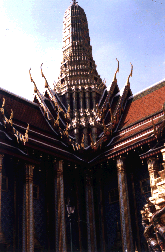
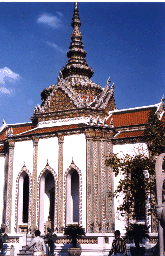
Phra Thep Bidorn was probably a Hindu image and was believed to represent King L Thong, the founder of Ayudhya. the capital prior to Bangkok. King Rama I had the sculpture brought down to Bangkok and recast into a crowned Buddha image covered with silver.
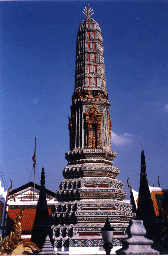 In front of the Temple of the Emerald Buddha on the east, the king had eight prang (towers) constructed (no. 21). They were dedicated respectively from the north to the south to the following important elements of Buddhist: the Buddha, the
Dhamma (the Law), the Sangha (Buddhist monks), the Bhikshuni (Buddhist nuns who existed in the old days), Pacchekabodhi Buddhas (Buddhas who attained Enlightenment but never preached), the chokravati (great emperors). the Bodhisava (the Buddha in his prev
ious lives, according to Theravada Buddhism) and the Maitreya (the future Buddha).
In front of the Temple of the Emerald Buddha on the east, the king had eight prang (towers) constructed (no. 21). They were dedicated respectively from the north to the south to the following important elements of Buddhist: the Buddha, the
Dhamma (the Law), the Sangha (Buddhist monks), the Bhikshuni (Buddhist nuns who existed in the old days), Pacchekabodhi Buddhas (Buddhas who attained Enlightenment but never preached), the chokravati (great emperors). the Bodhisava (the Buddha in his prev
ious lives, according to Theravada Buddhism) and the Maitreya (the future Buddha).
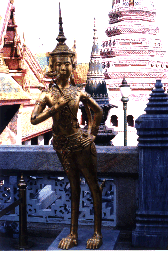 In the reign of King Rama II nothing was added, but in
the reign of his son, King Rama III, the whole temple was restored
since many buildings had decayed and were in the of repair
to make them appropriate for the celebration of the fiftieth anniversary of Bangkok in 1832. He began the restoration its 1831, one year before the festivities.
The king had the superstructure of the ubosoth restored
and changed the decoration to its exterior walls from gold on red
lacquer to gilt-stucco decorated with colored glass which is as
it appears today. He also had 112 figures of garuda (the king of
birds) holding naga (the king of snakes) cast in bronze to ornament
the base. The mural painting inside were newly painted as mentioned above except for the scenes of the Buddhist cosmology and
the Enlightenment of the Buddha, respectively, on the western and
eastern walls. The golden throne of the Emerald Buddha was
heightened, as noted previously, by an intermediary base. The
king had the superstructure of the galleries around the temple
changed and the whole story of the Ramakien (the Thai version
of the Hindu epic, the Ramayana) repainted. The White Viharn
of King Rama I was demolished, and the Viharn Yod, with
its superstructure in the form of a Thai crown ornamented with
multi-colored pieces of glazed terra-cotta, was built in its place.
The mother-of-pearl inlaid door of this structure dates back to
1753 in the reign of King Boromkot of the late Ayudhya period.
In the reign of King Rama II nothing was added, but in
the reign of his son, King Rama III, the whole temple was restored
since many buildings had decayed and were in the of repair
to make them appropriate for the celebration of the fiftieth anniversary of Bangkok in 1832. He began the restoration its 1831, one year before the festivities.
The king had the superstructure of the ubosoth restored
and changed the decoration to its exterior walls from gold on red
lacquer to gilt-stucco decorated with colored glass which is as
it appears today. He also had 112 figures of garuda (the king of
birds) holding naga (the king of snakes) cast in bronze to ornament
the base. The mural painting inside were newly painted as mentioned above except for the scenes of the Buddhist cosmology and
the Enlightenment of the Buddha, respectively, on the western and
eastern walls. The golden throne of the Emerald Buddha was
heightened, as noted previously, by an intermediary base. The
king had the superstructure of the galleries around the temple
changed and the whole story of the Ramakien (the Thai version
of the Hindu epic, the Ramayana) repainted. The White Viharn
of King Rama I was demolished, and the Viharn Yod, with
its superstructure in the form of a Thai crown ornamented with
multi-colored pieces of glazed terra-cotta, was built in its place.
The mother-of-pearl inlaid door of this structure dates back to
1753 in the reign of King Boromkot of the late Ayudhya period.
H.R.H. Prince Damrong Rajanubhab, father of Thai history and archaeology, surmised that originally surmised area at the northern side of the Temple of the Emerald Buddha contained four buildings, respectively, from the east to the west: the Supple- mentary Library (Ho Phra Monthien Tham, no I8), the White Viharn, the Ho Phra Thep Bidorn and the Ho Phra Nak. But in the reign of King Rams Ill the need arose for a rather large building in which to keep the ashes of the deceased members of the present Chakri Dynasty, so the king had the Ho Phra Thep Bidorn and the original Ho Phra Nak pulled down, and built instead a large building (no. 20) to preserve the ashes of the deceased princes and princesses. The images of Phra Thep Bidorn (the crowned Buddha image clad in silver) and Phra Nak (the large standing Buddha image in copper alloy) were transferred to the Viharn Yod (no. 19) and have remained there ever since. The large new building, though containing only the ashes of the deceased members of the present dynasty, has continued, however, to be called Ho Phra Nak (no. 20) up to the present day.
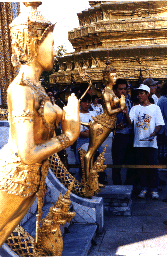 Apart from the above-mentioned buildings, King Rama Ill
restored structures such as the Library (Phra Mondop), the Supple-
mentary Library (Ho Phra Monthien Thaw), the small open pavilions
around the ubosoth, the belfry, the two golden stupa and the
eight prong (towers), etc., He embellished the grounds by constructing
small artificial stone hills, stone seats, and flower pots, and lined
the paths and entrances with Chinese stone sculptures. The king
also had a figure of a seated hermit,
Apart from the above-mentioned buildings, King Rama Ill
restored structures such as the Library (Phra Mondop), the Supple-
mentary Library (Ho Phra Monthien Thaw), the small open pavilions
around the ubosoth, the belfry, the two golden stupa and the
eight prong (towers), etc., He embellished the grounds by constructing
small artificial stone hills, stone seats, and flower pots, and lined
the paths and entrances with Chinese stone sculptures. The king
also had a figure of a seated hermit,
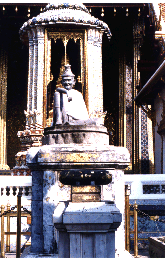 who was supposed to be a great physician, cast in bronze and installed behind the ubosoth to the west in front of a gate (no. 8). A grinding stone and a mortar were placed before the figure 50 that people could come to worship and grind their medicine for
greater efficacy.
who was supposed to be a great physician, cast in bronze and installed behind the ubosoth to the west in front of a gate (no. 8). A grinding stone and a mortar were placed before the figure 50 that people could come to worship and grind their medicine for
greater efficacy.
In the reign of King Rama IV (King Mongkut, 1851-1868), much reconstruction took place The tall terrace on which the Library (Phra Mondop, no 11) stands was enlarged both on its western and eastern sides and two tiers of stone railings were built around it. Six gates and staircases leading up to the Library were added as well as galleries on the east and the west. On the east a gate with a superstructure in the form of a Thai crown was built, flanked by two pavilions. On the west a gate with a four-sided top and a pavilion were constructed.
In front of the Library (no. 11) on the east the king built a pavilion with a prong (tower) summit, which is now called the Royal Pantheon. It was begun in 1856. At first the king wanted to transfer the Emerald Buddha there as he thought it was improper for the Buddha to be lower than the Tripitaka (the Law). But after the building was finished, it was found to be too small to perform any ceremony inside, so it was left vacant. The two gilt redented stupa (no. 10) also on the terrace in front of the Royal Pantheon on the east might have been built in this reign to replace the former two constructed by King Rama 1, which would have been on the ground.
To the west of the Library a stupa was constructed in imitation of a large one at Wat Phra Si Sanpet at Ayudhya. The construction began in 1855. The stops was called Phra Si Ratana Chedi and relics of the Buddha were enshrined in it. The golden mosaic adorning it at present, however. was not added until the reign of King Mongkut's son, King Rams V (King Chulalongkorn, 1868-1910).
The wooden superstructure of the Library (no. 11) was restored, and the thin flat pieces of silver which paved the floor inside were replaced by silver mats.
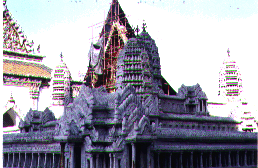 To the north of the Library King Mongkut had built a
model of Angkor Wat as it was during the period when
Cambodia was still a vassal state of Thailand. This model was
finished in the reign of King Rams V for the centenary celebration
of Bangkok
To the north of the Library King Mongkut had built a
model of Angkor Wat as it was during the period when
Cambodia was still a vassal state of Thailand. This model was
finished in the reign of King Rams V for the centenary celebration
of Bangkok

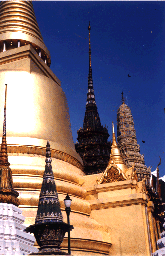 This Buddha has a halo in the form of a lotus
bud or a gem. He wears a monastic robe in a Chinese fashion and
his right hand is in the attitude of calling down the rain whereas
his left hand is trying to catch it. These two buildings were
ornamented with the present terra-cotta glazed tiles in the reign
of King Rams V. King Rams IV also had a site prepared in front
of the viharn enshrining the Grandhara Buddha for the stone sea
of King Ram Khamhaeng the Great (1279-1299) which King Ram
IV, when still in the monkhood, had brought down from the tow
of Sukhothai (This stone seat has now been removed to soothe
site.) To the south of the ubosoth a new belfry was constructed
probably on the site of the original one (no. 4).
This Buddha has a halo in the form of a lotus
bud or a gem. He wears a monastic robe in a Chinese fashion and
his right hand is in the attitude of calling down the rain whereas
his left hand is trying to catch it. These two buildings were
ornamented with the present terra-cotta glazed tiles in the reign
of King Rams V. King Rams IV also had a site prepared in front
of the viharn enshrining the Grandhara Buddha for the stone sea
of King Ram Khamhaeng the Great (1279-1299) which King Ram
IV, when still in the monkhood, had brought down from the tow
of Sukhothai (This stone seat has now been removed to soothe
site.) To the south of the ubosoth a new belfry was constructed
probably on the site of the original one (no. 4).
Behind the ubosoth on the west, King Rams IV also had constructed a pavilion having a prong superstructure decorate with glazed terra-cotta; this was to house an old bronze prong called Phra Pothithat Piman (no 6). He then had a small structure built on either side of this central pavilion. The northern structure named Ho Rachakaramanusorn (no. 7), houses thirty-four small bronze Buddha images in various attitudes dedicated to the thirty-three kings of Ayudhya and one king of Thonburi. The small Buddha images in various attitudes had been cast by command of King Rams III from copper found at Chantuk in the province Nakhon Ratchasima (Khorat) in northeastern Thailand The kit had asked his uncle, H.R.H. Prince Paramanuchit, who was in the monkhood, to invent forty attitudes for Buddha images aft the life story of the Master, but he had only thirty-four images cast. The mural paintings inside the building depicting the history of the Ayudhya period were executed by Khrua In Khong, eminent painter who was the first Thai to use westerns perspective Inside the southern building called Ho Rachapongsanusorn (no. f which was dedicated to the kings of the Chakri Dynasty, are or installed eight small Buddha images in different attitudes, ca one protected by a many-tiered umbrella. The moral painting inside portray the life of King Rams I or the history of Bangkok and probably were painted by an artist other than Khrua In Khong as the workmanship is not all the same.
King Rams IV also had both the roof of the ubosoth and the mural paintings on the lateral walls restored after the original style. The floor of the ubosoth was renovated and the windows were changed totally into mother-of-pearl inlaid work. The Chinese door-guardians and the angel window-guardians which had originally been painted were changed to gilt-stucco work decorated with colored glass. The glazed terra-cotta tiles around the base of the ubosoth were replaced.
The king also began the restoration of the galleries and the repainting of story of the Ramakien; this work was finished in the reign of King Rams V.
In the reign of King Rams V Bangkok was to celebrate its centenary anniversary in 1882; therefore, in 1880 the king asked all his younger brothers, some other princes and various officials to help him with the total renovation of the Temple of the Emerald Buddha. During this period, apart from the restoration of the already existing architecture, the gilt bronze figures of mythical beings presently on the terrace around the Royal Pantheon (no. 9) were cast and the Phra Si Ratana Chedi (no. 12) was entirely covered with golden mosaic. A numbed of stucco trays with conical covers supposedly containing betel nut sets were added as decora- tion on a lower stone railings around the terrace in the central part of the temple. Marble slabs engraved with poems describing the Ramakien story were embedded in gallery pillars opposite paintings of the same episode, whereas poems concerning the incarnations of Vishnu and the origins of demon and monkey families were placed on the wall near the paintings. These poems were composed by the king, some princes officials and Buddhist monks who were well versed in poetry'. Demon and monkey. caryatids were added to support the two gilt stupa (no. 10) in front of the Royal Pantheon. Many stone items to decorate the temple were also ordered. Two large pairs of demon-guardians at the gates were probably added during this period in imitation of the other eight demon gate-guardians made in the Third Reign.
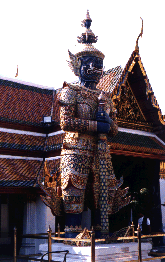 The king also had monuments erected for his ancestors
and himself on the terrace of the Royal Pantheon. The one at
the northwestern corner (no. 14) was dedicated to Kings Rams 1,
Rams II and Rams Ill, designated by their respective emblems,
the upper part of a crown, a garuda holdings naga, and a pavilion.
These gilt-bronze emblems were placed insides throne which was put
on top of a marble square pillar. Models in bronze of the white and
other important elephants of each reign surround its base. At the
southwestern corner (no. I5)a second monument was dedicated to
King Rams IV and bears his emblem, a crown, insides throne. The
third one, which was for himself, has his own emblem, a small crown
Chulalongkorn) placed on a cushion, inside a throne, and was
erected at the southwestern corner of the Royal Pantheon (no. 16).
The second and third monuments were also surrounded at the bass
with models in bronze of the white and other important elephant
of each reign.
The king also had monuments erected for his ancestors
and himself on the terrace of the Royal Pantheon. The one at
the northwestern corner (no. 14) was dedicated to Kings Rams 1,
Rams II and Rams Ill, designated by their respective emblems,
the upper part of a crown, a garuda holdings naga, and a pavilion.
These gilt-bronze emblems were placed insides throne which was put
on top of a marble square pillar. Models in bronze of the white and
other important elephants of each reign surround its base. At the
southwestern corner (no. I5)a second monument was dedicated to
King Rams IV and bears his emblem, a crown, insides throne. The
third one, which was for himself, has his own emblem, a small crown
Chulalongkorn) placed on a cushion, inside a throne, and was
erected at the southwestern corner of the Royal Pantheon (no. 16).
The second and third monuments were also surrounded at the bass
with models in bronze of the white and other important elephant
of each reign.
As for the foreign objects that King Rams V had acquired from various countries, he arranged them in the Temple of the Emerald Buddha; for instance, the five volcanic stone Dhyani Buddhas of the 8th century A.D. that the king had obtained from Borobudu on the island of Java. He had them placed on the terrace south of the Library (Phra Mondop, no. 11), but in the reign of King Rams Vi (King Vajiravudh, 1910-1925), the king remover four of them and enshrined them in the niches of a new chedi that he had erected at Wat Rachathiwat in Bangkok The fifth on' was transferred to Wat Bovorniwet, also in Bangkok. As for the four stone Dhyani Buddhas that King Rams V obtained from Chandi Plaosan (9th-10th century A.D.), also on Java, the King had them placed at the four corners of the Library (Phra Mondop, 00.11). But for the Bicentenary Celebration of Bangkok in 1982, H.R.H. Princess Maha Chakri Sirindhorn, the second daughter of the present king (H.M. King Bhumibol, Rams IN), as Chairman of the Committee for the Restoration of the Temple of the Emerald Buddha for that auspicious occasion, had them transferred for their protection and preservation to the Museum of the Temple of the Emerald Buddha which she created inside the old building of the Department of Pages on the northern side of the Dusit Mansion in the Grand Palace. She had copies put at their previous sites, and also removed to the new museum four pairs of stone statues portraying characters in dramas composed by King Rams II: the Ramakien, Kraitong, Sangtong or The Prince of the Golden Conch, and Manora. These statues were probably carved in the reign of King Rama III and placed at the four corners of the ubosoth at that time.
Foreign objects dating back to the reign of King Rams V and the later period which are still kept inside the ubosoth include a pulpit, flower pots and decorative figures of Italian marble which might have been offered by King Rams V to the Emerald Buddha after one of his two trips to Europe, and gifts brought by others.
The total restoration of the Temple of the Emerald Buddha by King Rams V in 1882 might he considered as the second largest restoration since the temple was built.
One evening in 1903 a great fire broke out on the roof of the Royal Pantheon (no. 9) because the electrical wires were worn. As a result its superstructure had to be rebuilt and later on the wooden root' of the Library (Phra Mondop, no 11) was also restored. This restoration was accomplished in the reign of King Rams VI.
In the reign of King Rams VI the king had the Royal Pantheon, which had been empty since the time of its founder, King Rams IV, turned into the Royal Pantheon of the Chakri Dynasty. Five statues of the past kings were removed in 1918 to the Royal Pantheon from the Sivalai Mansion, which is inside the Grand Palace to the south of the temple. At this time the two gilt stupa were also moved to their present sites east of the terrace. Four grand marble staircases were constructed leading up to the top part of the terrace on the east, the north and the south as well as leading op to the Phra 5 Ratatta Chedi (no, 12; on the southern side. The steps of the six staircases of the ubosoth were lowered in order to facilitate climbing them and were paved with marble The stone seat of King Ram Khamhaeng the Great, which had originally been set up in front of the viharn of the Gandhara Buddha, was transported to the Dusit Pavilion and installed there as a throne underneath a whit nine-tiered umbrella, one of the royal regalia.
In the reign of King Rama VII (King Prajadhipok, 1925
1934), Bangkok celebrated its 150's anniversary in 1932 and the
Temple of the Emerald Buddha was totally restored again, especially'
the paintings of the Ramakien along the galleries
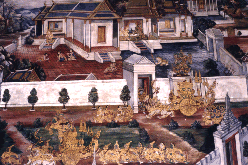 , whirl had been much damaged by rain and dampness. They well
completely repainted. The stone seat of King Ram Khamhaeng
the Great, which had been transformed into a throne in the Dusit
Mansion, was transferred by command of the king to the Ananta
Samakhom Audience Hall, but after the coup d' etat in June 193:
changing the system of absolute monarchy into a constitutions
one, the king ordered that the stone seat be taken back to the
Viharn Yod in the Temple of the Emerald Buddha (no. 19) ant
preserved there without the white nine-tiered umbrella.
, whirl had been much damaged by rain and dampness. They well
completely repainted. The stone seat of King Ram Khamhaeng
the Great, which had been transformed into a throne in the Dusit
Mansion, was transferred by command of the king to the Ananta
Samakhom Audience Hall, but after the coup d' etat in June 193:
changing the system of absolute monarchy into a constitutions
one, the king ordered that the stone seat be taken back to the
Viharn Yod in the Temple of the Emerald Buddha (no. 19) ant
preserved there without the white nine-tiered umbrella.
During the present reign, that of King Bhumibol or King
Rams IX, Bangkok celebrated its Bicentenary in 1982. H.R.H.
Princess Maha Chakri Sirindhorn, as Chairman of the Committee
for the Restoration of the Temple of the Emerald Buddha, received
a tremendous amount of financial aid from the public apart from
the budget set by the government. Every building in the temple
was restored in detail as well as the golden throne of the Emerald
Buddha, the Buddha images in the ubosoth and the paintings of
the Ramakien along the galleries.
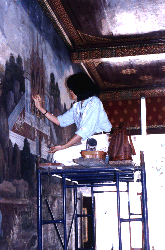
The stone seat from the Sukhothai period was removed from the Viharn Yod to be installed ass throne under a white nine-tiered umbrella in the new museum so that the public can pay respect to and remember the beneficent of King Ram Khamhaeng the Great. Also in this museum are displayed the seasonal costumes of the Emerald Buddha, various offerings presented to that sacred image, and some samples of architectural fragments that have been replaced by new' ones. The Princess also had a monument erected on the northwestern corner of the Royal pantheon (no. 17) in commemoration of the Bicentenary of Bangkok. It consists of the four emblems of Kings Rants VI., VII, VIII and IX, respectively; the weapon of Indra that causes lightning (vajiravudh, the emblem of three arrows under a crown, a male divinity, and the number 9 inside a discus with a nine-tiered umbrella on top. These four gilt-bronze emblems were set inside a throne which "as placed upon a square marble pillar surrounded at its base with bronze models of the white and other important elephants of' their respective reigns. This monument resembles the three others dedicated to their ancestors (nos. 14, IS and 16) which were erected during the centenary cerebra- tion of Bangkok.
It can be concluded that the Temple of the Emerald Buddha, the most sacred temple of Thailand, has been restored in every alternate reign. It was constructed in the reign of King Rama 1 and largely restored in the reigns of Kings Rams III, V. VII and IX. In other words, it has had major repairs every fifty years.